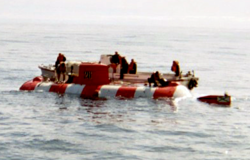Project 1855
|
AS-28
|
||||||||||||
|
||||||||||||
|
||||||||||||
|
||||||||||||
|
||||||||||||
The Project 1855 (Project Name Russian Приз , transcription Pris , dt. "Price") is a submarine class of Soviet production. The rescue submarines are in service with the Russian Navy today and are supposed to rescue crews from sunken submarines.
Four Pris were built between 1986 and 1991. They are 13.5 meters long and 5.7 meters high. The water displacement is 55 m³, submerged 110 m³. The boats have a maximum diving depth of 1,000 m. They have a titanium hull. In the Russian Navy, they are considered efficient and safe. With an electric drive, a maximum speed of around 3.7 knots (6.9 km / h) is achieved under water . The mini submarines can be deployed up to wind force 6. According to Russian information, there is air on board for up to 120 hours. There is a military boat type similar to the Pris named Bester ( Project 18270 ).
With a crew of four, the boat can save up to 20 people per dive. During a rescue maneuver, it docks to the escape hatches of the crashed submarine.
This type of submarine was also involved in the failed Kursk nuclear submarine rescue mission in 2000. The limits of this system also became apparent, as the rescue submarines could not dock on the sloping wreck and were restricted by the weather conditions.
The accident off the Kamchatka Peninsula
This type of submarine gained worldwide fame in 2005 due to the accident of the AS-28 type Pris of the Pacific fleet with seven crew members on board in Berezovaya Bay, about 70 km southeast of Petropavlovsk-Kamchatsky off Kamchatka .
Depending on the source (and time zone), the boat got caught between August 3rd and 5th, 2005 in cables of an underwater eavesdropping system and an old fishing net at a depth of around 190 m.
Unlike the Kursk accident, this time the Russian Navy immediately called for international help. Great Britain and the USA brought unmanned diving robots with transport aircraft , and Japan brought four military ships, including a special ship for such missions, to the scene of the accident to support the rescue operation of the Russian Navy. The crew were instructed to save breathing air.
The AS-28 boat was built in 1989 in Gorky at the Krasnoye Sormowo shipyard. Some sources (e.g. Handelsblatt, ZDF) reported a comment from this shipyard about an upcoming overhaul that was planned for November 2005 at the shipyard. Other sources speak of a general overhaul carried out shortly before the accident (Spiegel).
In the early morning of August 7, succeeded in arrivals as the first Scorpio - diving robots to sever the British Royal Navy Submarine Rescue Service, the steel cables with which the boat was detained on the seabed. The entire crew was able to leave the boat independently after surfacing at 5.26 a.m. (CET). She was weakened and with hypothermia, but otherwise unharmed, was taken to a military hospital after about 76 hours on the seabed.
The Japanese ships turned again.
